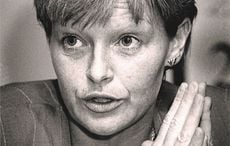While Irish women continue to make long overdue and steady, if slow, advances toward equality in an overarching sense, an examination of their progress in the political arena is far less heartening. This may surprise casual observers of Irish politics who can point to Ireland’s two trailblazing and outstanding female presidents, Mary Robinson and Mary McAleese, or to capable and powerful TDs (members of the lower house of Irish parliament), like former Tánaiste, (deputy Irish prime minister) Mary Harney, and former Minister for Justice, Nora Owen. The numbers do not lie, however.
In last year’s general election, just 85 of 566 candidates for 166 seats in Dáil Éireann (lower house of Irish parliament) were women. There were six male candidates for every female candidate. There are just 25 female TDs; 85% of TDs are men. This puts Ireland in 76th place on the international league table when it comes to the representation of women in national legislatures. It comes just ahead of Zimbabwe.
By way of comparison, in Britain, more than 20% of the membership of the Westminster parliament is female. In Sweden, women constitute nearly 50% of elected members of parliament.
In-depth research conducted recently by academics at the National University of Ireland, Maynooth adds another layer to the easily diagnosed lack of gender parity in Irish politics. Women account for 34% of the overall membership of Fianna Fáil, but just 15% of its candidates in the 2011 general election. The discrepancy is still worse within the largest parliamentary party, Fine Gael. 42% of its membership is female, and only 15% of its candidates were women last year.
------------------
Read more:
Galway plans to build monument to Che Guevara slated by local millionaire
My top ten Irish bucket list especially for St. Patrick’s day - PHOTOS
------------------
The discrepancy is less pronounced in the left of center Labour Party – 37% of the membership, 27% of the candidates – and in leftist Sinn Féin – 24% of the membership, 20% of the candidates. Across the board, the parties clearly have a lot of work to do on increasing the numbers of female members and office seekers.
Two questions naturally follow the revelation of the numerical realities. First, is the lack of female political candidates and office holders a problem? The answer to this would seem axiomatic. In a society comprised of men and women in roughly equal numbers, it seems fair and logical that they should be represented in the same roughly equal numbers in the law and policy making process. That is not to say that male elected officials cannot be effective champions for women or vice versa. Yet it is to say that men and women should have seats at the table and it is to acknowledge that there are differences between the sexes. Both must have a genuine say in the formation of law and policy if equality is to be anything other than notional.
The second question is how does Ireland solve the problem? To arrive at a potential solution, it is necessary to first consider the problem’s causes. Researchers have pinpointed what they call the “4 Cs.” First and foremost is care. Women spend far more time caring for children and for the home than men do. Second is the cultural bias that persists about gender roles. Third is cash, given that women’s income lags behind their male counterparts. Fourth is confidence, or lack thereof. Many women profess that they are intimidated by the “old boys’ network” that still exists in politics.
The decision of one highly regarded and very talented TD not to seek re-election last year reflects how at least one of the “4 Cs” operates. Olwyn Enright, a strong electoral performer in her Laois-Offaly constituency and a rising star within the Fine Gael parliamentary party, declined to seek a third term after the birth of her second child. As she said, “my personal circumstances have changed greatly since I was first elected and in the longer term, with a young family, I will not be in the position to give the enormous commitment the position requires, and my constituents deserve.”
Although a majority of mothers now work outside the home, few of them have as demanding a job as a TD. Reflecting on Olwyn Enright’s departure from politics, another former TD who left politics to raise a family, Mildred Fox, noted the grim reality of leaving “children for days on end to fulfil a gruelling schedule, which requires long hours at meetings, functions, funerals, endless car journeys, all the while keeping up to date with a variety of issues.”
In order to solve the problem, advocates in Ireland have identified a fifth “C” – candidate selection – and have turned to international best practices for increasing the number of female candidates for political office. And here is where things get controversial. Lawmakers in other countries have used the bluntest of blunt instruments, quotas, to ensure that political parties select women as candidates. At the moment, draft legislation has been proposed that would require Irish political parties to select 30% women candidates in the 2016 general election and 40% by the mid 2020s. Parties that fail to comply would have their state funding cut.
Quotas, or “positive discrimination measures,” do not carry the same stigma in Europe as they do in the United States. In the US, racial, gender, ethnic and other quotas trigger constitutional concerns and lie comfortably on the political third rail. The use of a quota system to increase the almost equally dismal participation rate of women in American politics – women comprise just 17% of the membership of the US Congress – would never pass muster, even in the extremely unlikely event that American political parties were to abandon open primaries and select candidates as they do in Ireland. Quotas have come to be regarded as downright “un-American.” Europeans are not as instinctively opposed. But the proposed quotas have provoked robust debate here and a number of Irish female office holders themselves are against something they fear could lead to “tokenism.”
I’m not sure if my inescapably American mindset will ever allow me to support a quota system, yet it is manifest that women are grossly underrepresented in Irish politics. Drastic action of some kind is indeed necessary to change the longstanding, unequal state of play. Advocates for greater female participation in Irish politics only wish their elected representatives to more accurately mirror the people whom they are lucky enough to represent. Their wish and their work to that end accord with democracy’s highest ideals. As such, I hope they succeed.




Comments